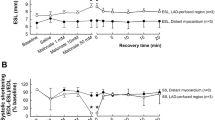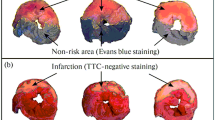Summary
Limitation on infarct size, using propionyl-L-carnitine (Sigma-Tau) by itself and with the calcium entry blocker, tiapamil (Hoffmann-LaRoche), was evaluated in two groups of ten dogs each, during chronic (9 days) myocardial infarction. There were eight dogs that served as the control group. A closed-chest model was used to produce the thrombus by placing a helically shaped copper wire in the LAD by catheter technique, under x-ray visualization. Necrotic tissue in serial transventricular sections were delineated by triphenyltetrazolium chloride and measured by computer technique, using an IBM PC interfaced with a digitizing pad, 9 days following occlusion. The mean total amount of necrosis in the propionyl-L-carnitine (7.4%) and the propionyl-L-carnitine/tiapamil (6.7%) groups were significantly less (p<.01) than found in the control (14.1%) group, reflecting a difference of 50 and 58%, respectively, between the treated groups and control. A number of significant between-group comparisons (p<.05 to p<.001), under the same conditions, were found for various ischemia, hemodynamic, and hematologic variables followed before and at 30, 60, 90, 120, and 180 minutes after occlusion, as well as on the second and ninth day. The results of this study strongly suggest that propionyl-L-carnitine and propionyl-L-carnitine with tiapamil has a protective effect on myocardial function, following thrombotic occlusion of the LAD, as well as limiting the resulting infarct size.
Similar content being viewed by others
References
Opie LH. Metabolism of the heart. Am Heart J 1968;76:685.
Fritz IB, Kaplan E, Yue KTM. Specificity of carnitine action on fatty acid oxidation by heart muscle. Am J Physiol 1962;202:117.
Shug AL, Thomsen JH, Folts JD, et al. Changes in tissue levels of carnitine and other metabolites during myocardial ischemia and anoxia. Arch Biochem Biophys 1978;187(1): 25–33.
Folts JD, Shug AL, Koke JR, et al. Protection of the ischemic dog myocardium with carnitine. Am J Cardiol 1978;41(7):1209–1214.
Shug AL, Shrago E, Bittar N, et al. Acyl-CoA inhibition of adenine nucleotide translocation in ischemic myocardium. Am J Physiol 1975;228(3):689–692.
Giles DT. Calcium antagonists: An overview. Angiology 1982;33(8):489.
Winniford MD, Willerson TT, Hillis LD. Calcium antagonists in the treatment of individuals with ischemic heart disease. Angiology 1982;33(8):516.
Kival J, Myerburg RJ. The hemodynamic effects of calcium channel blocking agents: A brief review. Angiology 1982; 33(8):516.
Ruedy J. Verapamil (review article). Clin Invest Med 1981;4(2):129.
Zsoter TT. Calcium antagonists. Am Heart J 1980;99(6):805.
Council on Scientific Affairs (AMA). Calcium channel agents. JAMA 1983;250(18):2522.
Singh BN. Pharmacological basis for the therapeutic applications of slow-channel blocking drugs. Angiology 1982; 33(8):492.
Alps BJ, Wilson A. The beneficial effect of nicardipine compared with nifedipine and verapamil in limiting myocardial infarct size in baboons. Arzniem-Forsch/Drug Res 1983; 33(6):868.
Krikler DM, Harris L, Rowland E. Calcium-channel blockers and beta blockers: Advantages and disadvantages of combination therapy in chronic stable angina pectoris. Am Heart J 1982;104(3):702.
Chakravarti RN, Sharma PL, Anand IS, et al. Effects of verapamil (isoptin) on experimental myocardial infarction in rhesus monkeys. Indian J Med Res 1981;73:625.
Kordenat RK. Electrocardiogram during experimental coronary thrombosis. J Electrocardiol 1976;9(1):41.
Kordenat RK, Leasure J. Effect of tiapamil on canine myocardial infarct size. Am Heart J 1986;111(3):502.
Kordenat RK, Kezdi P, Stanley EL. A new catheter technique for producing experimental coronary thrombosis and selective coronary visualization. Am Heart J 1972;83:360.
Author information
Authors and Affiliations
Additional information
Supported by Sigma-Tau, Industrie Farmaceutiche Riunte S.p.A., Pomezia, Rome, Italy
Rights and permissions
About this article
Cite this article
Leasure, J.E., Kordenat, K. Effect of propionyl-L-carnitine on experimental myocardial infarction in dogs. Cardiovasc Drug Ther 5, 85–95 (1991). https://doi.org/10.1007/BF00128247
Issue Date:
DOI: https://doi.org/10.1007/BF00128247




